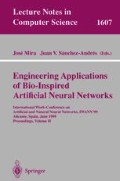Abstract
This paper presents first results of an Adaptive Brain Interface suitable for deployment outside controlled laboratory settings. It robustly recognizes three cognitive mental states from on-line spontaneous EEG signals and may have them associated to simple commands. Three commands allow interacting intelligently with a computer-based system through task decomposition. Our approach seeks to develop individual interfaces since not two people are the same either physiologically or psychologically. Thus the interface adapts to its owner as its neural classifier learns user-specific filters.
Preview
Unable to display preview. Download preview PDF.
References
Anderson, C.W., Sijercic, Z.: Classification of EEG signals from four subjects during five mental tasks. Intl. Conf. on Engineering Applications of Neural Networks (1996) 407–414.
Babiloni, F., et al.: Improved realistic Laplacian estimate of highly-sampled EEG potentials with regularization techniques. Electroencephalography and Clinical Neurophysiology 106 (1998) 336–343.
Bernardi, M., Canale, I., et al.: Ergonomy of paraplegic patients working with a reciprocating gait orthosis. Paraplegia 33 (1995) 458–463.
Kalcher, J., et al.: Graz brain-computer interface II. Medical & Biological Engineering & Computing 36 (1996) 382–388.
Kohonen, T.: Self-Organizing Maps. 2nd ed. Springer-Verlag, Berlin (1995).
Marciani, M.G., et al.: Quantitative EEG evaluation in normal elderly subjects during mental processes. International Journal of Neurosciences 76 (1994) 131–140.
McFarland, D.J., et al.: Spatial filter selection for EEG-based communication. Electroen-cephalography and Clinical Neurophysiology 103 (1997) 386–394.
Millán, J. del R.: Rapid, safe, and incremental learning of navigation strategies. IEEE Trans. on SMC-Part B, 26 (1996) 408–420.
Millán, J. del R., Mouriño, J., et al.: Incremental networks for the robust recognition of mental states from EEG. Technical Report, Joint Research Centre of the EC, Italy (1998).
Platt, J.: A resource allocating network for function interpolation. Neural Computation 3 (1991) 213–225.
Varsta, M., Millán, J. del R., Heikkonen, J.: A recurrent self-organizing map for temporal sequence processing. 7th Intl. Conf. on Artificial Neural Networks (1997) 421–426.
Author information
Authors and Affiliations
Editor information
Rights and permissions
Copyright information
© 1999 Springer-Verlag Berlin Heidelberg
About this paper
Cite this paper
Millán, J.d.R. et al. (1999). Adaptive Brain Interfaces. In: Mira, J., Sánchez-Andrés, J.V. (eds) Engineering Applications of Bio-Inspired Artificial Neural Networks. IWANN 1999. Lecture Notes in Computer Science, vol 1607. Springer, Berlin, Heidelberg . https://doi.org/10.1007/BFb0100488
Download citation
DOI: https://doi.org/10.1007/BFb0100488
Published:
Publisher Name: Springer, Berlin, Heidelberg
Print ISBN: 978-3-540-66068-2
Online ISBN: 978-3-540-48772-2
eBook Packages: Springer Book Archive

